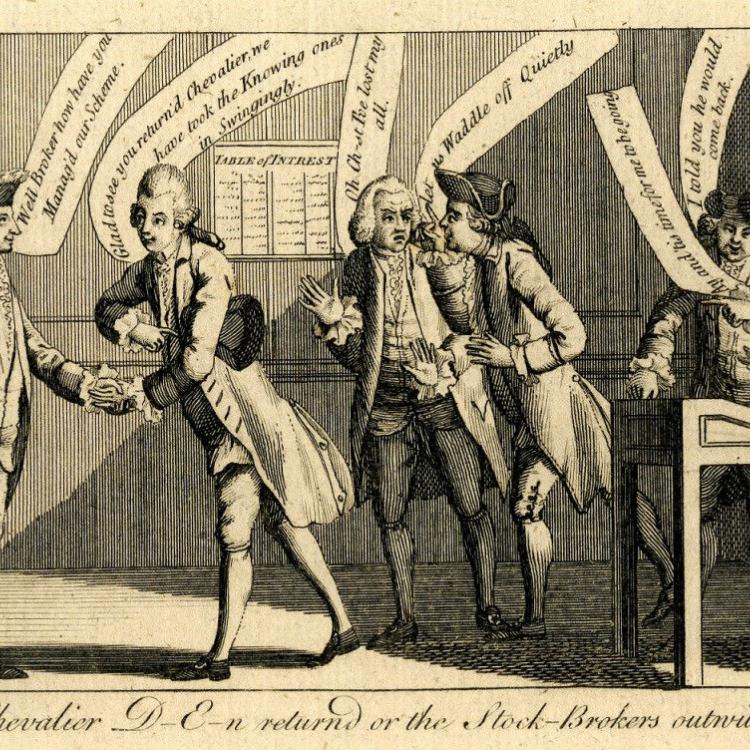Room 2
View a medal showing the Chevalier with the inscription 'MADAME D'EON'
Gender diversity at the British Museum
The Museum collection offers insights into gender diversity from ancient times to the present day highlighting that gender fluidity and diversity have always been integral to human experience. In mythology gender is often fluid. Androgyny – the combination of male and female characteristics – also occurs in many religious and cultural traditions around the world.
Here we look at gender diversity through the life of Chevalier d'Eon (1728–1810) and a selection of prints in the Museum collection.
Chevalier d'Eon
A celebrated 18th-century soldier, diplomat and spy, the Chevalier d'Eon lived openly as a man and as a woman in France and England at different stages of life, drawing much public interest. Charismatic and talented, the Chevalier inspired the production and circulation of printed images like those highlighted here.
Tracing the Chevalier's story isn't easy – obscured by conflicting accounts, speculation and rumour – it's challenging to present a clear picture of this remarkable life.
There's also complexity in using today's language and definitions to talk about the Chevalier's gender identity. But the Chevalier's biography,The Military, Political and Private Life of Mlle d'Eon, and surviving personal correspondence, provides a great deal of insight into their life in their own words. Prints and other objects from our collection, reflect the public fascination with this intriguing personality at particular moments in their life.
It must indeed be acknowledged that she is the most extraordinary person of the age ... we have seen no one who has united so many military, political, and literary talents
- The Annual Register for 1781, London.
Scandals, letters and negotiations
The Chevalier was born on 5 October 1728 to a minor aristocratic family in Burgundy.
Bright and articulate, d'Eon worked as a spy and diplomat for King Louis XV of France in Paris. After a stint as a Captain in the French Dragoons, they were sent to London as a diplomat. They embraced London life and continued to spy for the King before falling out with a superior.
The Chevalier then sought political exile in London and published secret diplomatic documents in Lettres, memoires et negociations, one of the most scandalous books of the time.
The controversy caused by the book meant that d'Eon – whose name had formerly only been known in court and diplomatic circles – became something of a celebrity in London.
This print is the earliest of the Chevalier in the British Museum's collection. It was made in London by the expatriate French printmaker and miniaturist Vispré in 1764, after d'Eon's book had been published. The year is not lettered on the print but has been added in the hand of its former owner, Horace Walpole.
The collection records no further portrait prints of d'Eon until the summer of 1771, by which time the question of the Chevalier's gender had become a matter of national interest.
Desperate measures
There had long been rumours in both Britain and France that the Chevalier was a woman, which developed into intrusive, prurient public interest.
Having acquired almost celebrity status by 1771, London bookmakers had even begun to take bets on d'Eon's gender as the public debate raged on.
From late 1777 onwards, the Chevalier began to permanently present as a woman.
When the French Revolution began in 1789, d'Eon's annual French pension was suspended and money became scarce. Ever resourceful, the Chevalier began to perform fencing exhibitions in women's dress, astonishing audiences and becoming a popular personality. Although finances remained tight, d'Eon had become a celebrity and prints were published showing these famous fencing matches.
A pioneer
The Chevalier was depicted in numerous satirical prints, many dating from the period of the gender scandal.
The print reproduced here is the first to offer an accurate representation of the Chevalier as a woman. D'Eon is depicted, without satirical intent, as a middle-aged woman in lace cap and gown, with the Cross of St Louis – awarded for bravery in battle and services as a spy – prominantly on view.
In old age, the Chevalier lived with a widowed friend, Mrs Coles, in modest circumstances. Despite the fame and notoriety that had accompanied this remarkable life, d'Eon died in poverty in May 1810, at the age of 81.
Today the Chevalier is recognised as a talented and tumultuous personality, who was celebrated both as a man and as a woman during a long and eventful life.
Chevalier d'Eon at the Museum
The British Museum's collection includes a large number of works relating to the Chevalier d'Eon. Most are works on paper which cannot be placed on permanent display for conservation reasons.
- View all items in the collection related to the Chevalier on Collection online
- Make an appointment to see works on paper in our Prints and Drawings Study Room
- View a medal with a portrait of d’Eon made in 1777 in Room 2: Collecting the world





